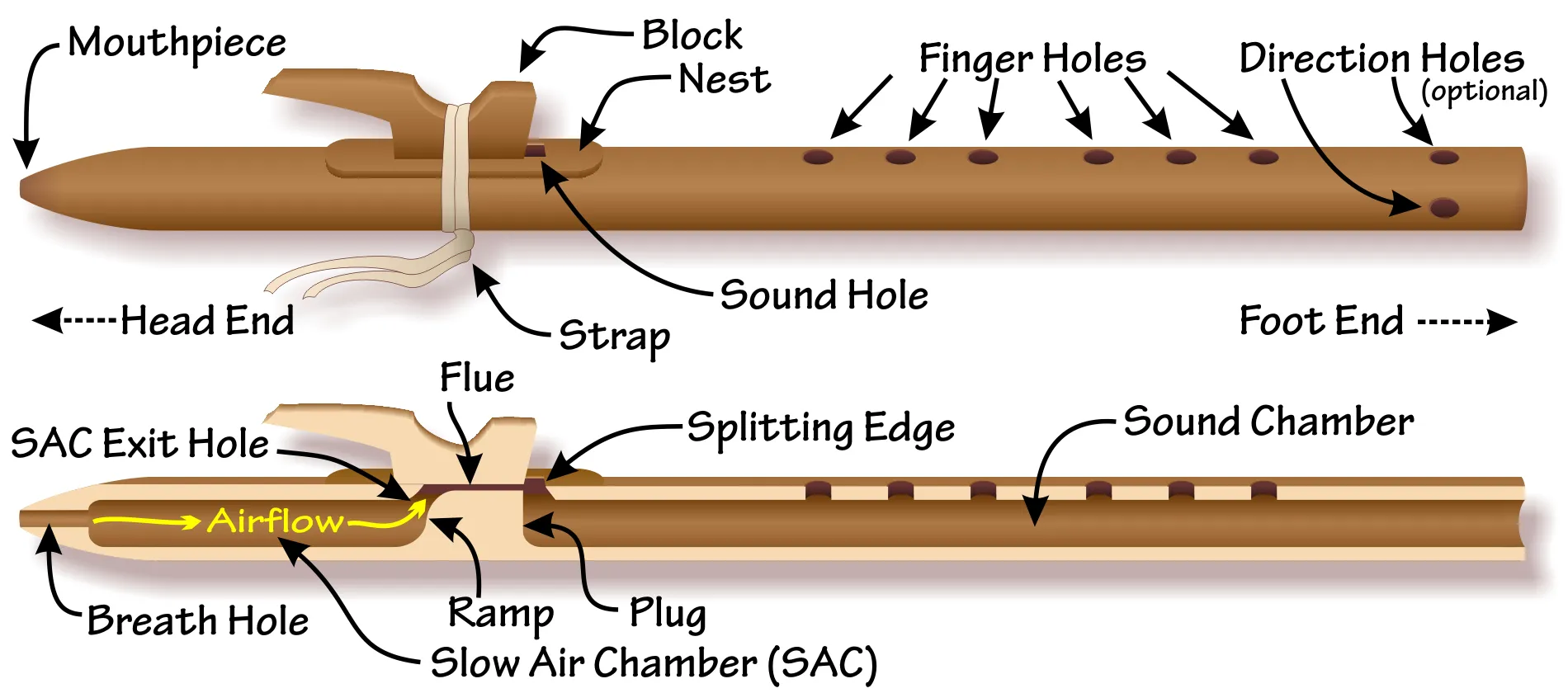In the world of music, few instruments hold the enchantment and cultural significance of the Native American flute. Its hauntingly beautiful melodies have resonated through the annals of history, carrying with them the stories and spirits of indigenous peoples.
Today, we embark on a musical odyssey as we explore the art of crafting a Native American flute with the skilled hands of Native American Clothes. Join us on this harmonious journey where wood, craftsmanship, and tradition harmonize to create the magic of the Native American flute.
How To Make A Native American Flute?

The captivating world of Native American flutes in the Southwest is a rich tapestry of diversity and tradition. Let’s delve into this enchanting realm where the flutes were as unique as the tribes and artisans who crafted them. From the materials used to the melodies produced, each flute tells a story of culture, history, and the resilience of Native American heritage.
Craftsmanship Beyond Conformity
The first thing that strikes you about Southwest Native American flutes is their remarkable individuality. There was no one-size-fits-all approach to flute making in this region. Each tribe, each artisan, infused their unique touch into every instrument they created. As we journey through this world of music, we’ll discover how these flutes defied convention and celebrated diversity.
Flutes: Not One Size Fits All
In the realm of Native American flutes, variety reigns supreme. The length of these flutes varied greatly, a testament to the different needs and preferences of the players. Some believed that the flute’s length should correspond to the distance from fingertip to elbow, while others simply sought comfort in their grasp.
The number of finger holes added another layer of diversity. From the three-hole Apache flutes to those boasting five or six holes, there was no standard. The placement of these holes was equally variable, adjusted to the player’s hand size and comfort. Whether drilled or burned into the material, each hole told a unique story.
Materials as Diverse as the Tribes
Native American flutes drew upon the bountiful resources of the Southwest. Various woods, bone, reed, clay, and even metal found their way into these instruments. The choice of materials often reflected the tribe’s traditions and the artisan’s expertise.
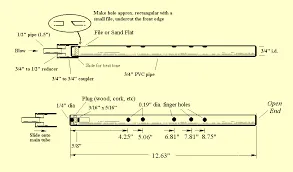
Two Distinct Styles: Pueblo and Apache
Within the realm of vertically-held flutes, two main styles emerged: the Pueblo and Apache flutes. Pueblo flutes were typically crafted from bamboo or cane, featuring six holes grouped into threes. The distinctive V-shaped notch allowed players to breathe life into their melodies.
Apache flutes, also crafted from bamboo or cane, took a different approach. These flutes had only three holes and featured two notches at the upper end. The first notch, known as a “bandage,” was covered by a finger or buckskin, while the second served as a vent. Sound was produced by blowing directly into the end of the flute.
A Chapter Lost in Time
Sadly, the rich tradition of Native American flute making and playing faced near-extinction due to the oppression and cultural suppression endured by Native Americans. This dark chapter left us with limited knowledge of how and why these flutes were made and played.
Reviving the Melodies
The 1970s marked a turning point as the art of Native American flute making and playing experienced a revival. Thanks to recordings and the contributions of musicians like Doc Tate Nevaquaya, Tom Mauchahty Ware, and Kevin Locke, the haunting melodies of the Native American flute echoed once more.
The Scholar’s Notes: R. Carlos Nakai
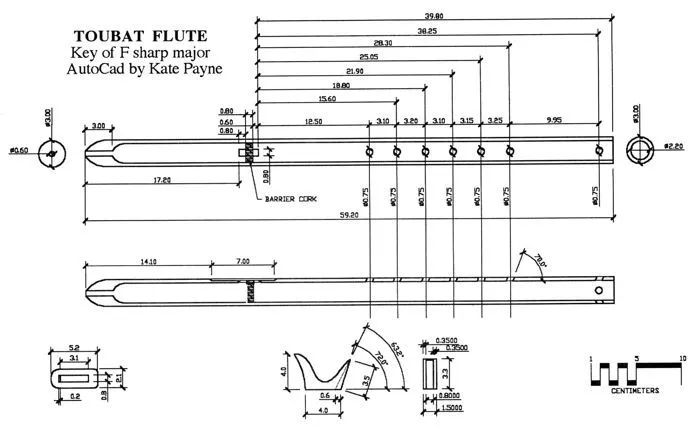
R. Carlos Nakai emerged as a pivotal scholar in the world of Native American flute construction and playing. His extensive studies revealed that these flutes didn’t adhere to a diatonic scale but explored lydian, mixolydian, dorian, and phrygian modes. Nakai even devised a fingering system for these flutes, drawing inspiration from the Boehm fingering system.
The Resonance of Modernity
Today, a contemporary version of the Native American flute, known as the “end-blown flute,” thrives. Crafted by both Native Americans and non-Native Americans, this flute retains the vertical playing style. Notably, a wooden “block” now covers the upper notch, replacing the finger or bandage of old.
Harmonizing with Tradition
While there’s still some variance in modern flutes, a burgeoning standard is taking shape. Most makers aim to tune their flutes to the European standard (A=440). Though intonation challenges persist, the Native American flute’s unique sound continues to captivate hearts and inspire musicians.
Its distinct pitches resonate with classically-trained ears, sparking a surge in popularity and the creation of music tailored for these beautiful instruments.
In the world of Southwest Native American flutes, diversity is not just celebrated; it’s the very soul of the music. Each flute, with its unique characteristics and history, adds a new layer to the rich tapestry of Native American heritage. As we continue our exploration, we’ll uncover the melodies, traditions, and stories that these remarkable instruments hold
What tools do you need to make a Native American flute?
Crafting a Native American flute is an art that bridges tradition and craftsmanship. With a handful of simple tools and a touch of dedication, you can create an instrument that resonates with the soul. Let’s take a journey into the world of flute-making, exploring the tools that bring these enchanting melodies to life.
When it comes to crafting a Native American flute, simplicity is key. You don’t need a vast workshop filled with heavy machinery; a modest collection of hand tools will suffice. Here’s a glimpse into the toolkit that transforms raw materials into the sweet notes of a flute.
1. The Thick Knife: Splitting the Branch
It all begins with a trusty thick knife. This is your gateway to the raw material – a branch that will soon sing with melodies. With careful precision, you’ll split the branch, laying the foundation for your flute’s body.
2. The Craft Knife: Fine Detailing
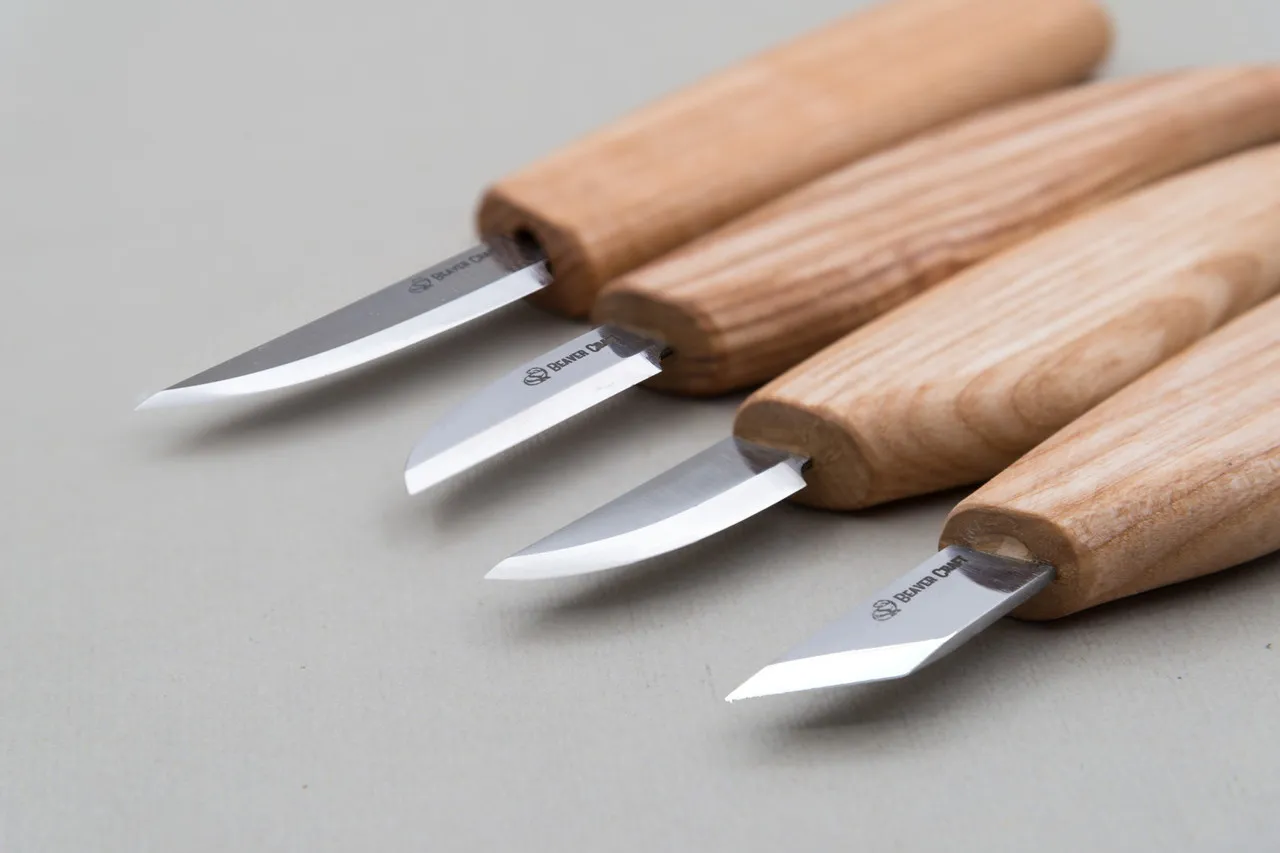
Next up, the craft knife. This smaller, more delicate tool allows you to refine the wood, shaping it with finesse. Every curve and contour of the flute’s body takes shape under the guidance of the craft knife.
3. Round and Flat Chisels: Carving the Soul
Carving is an intricate part of flute-making, and you’ll need two types of chisels to master it. The round chisel adds depth and character, while the flat chisel ensures precision in your craft.
4. Wood Glue: Binding the Melodies
As your flute comes together, wood glue becomes the glue that binds not just the wood but the very essence of the instrument. It’s the invisible force that holds your creation together.
5. Sanding Paper: Smoothing the Edges

Every flute deserves a smooth finish, and that’s where sanding paper comes in. It’s the tool that polishes your creation, leaving it both visually appealing and tactilely satisfying.
6. Woodworking Clamps: Securing the Pieces
In the delicate dance of flute-making, woodworking clamps play a crucial role. They ensure that each piece aligns perfectly, creating a harmonious instrument.
7. Brushes and Fabric: Adding the Final Touch
Once the body is ready, it’s time to add the finishing touches. Brushes and pieces of fabric come into play as you apply oil and lacquer, giving your flute a beautiful, protective sheen.
8. Electric Burner and Small Power Drill: Crafting the Sound Mechanism
The sound mechanism is the heart of your flute, and it requires a few special tools. An electric burner and a small power drill help you create the holes and fine-tune the sound, ensuring it resonates just right.
9. Small Files: Precision in Sound
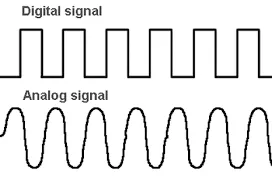
To perfect the sound, small files are your best friends. They allow you to make subtle adjustments, shaping the flute’s voice to your liking.
Crafting Simplicity
What’s remarkable about crafting Native American flutes is that you don’t need an expansive workshop or heavy machinery. These simple tools, often requiring minimal electricity, are enough to bring your flute to life.
Your Flute-Making Journey
If you’re new to flute-making, don’t be daunted by the list of tools. Many of these are small, space-efficient, and may already be in your possession. For those you don’t have, a bit of shopping will suffice.
As you embark on your flute-making journey, remember that it’s not just about crafting an instrument; it’s about connecting with a tradition that spans generations. With these humble tools, you have the power to create melodies that echo through time. So, gather your tools, embrace the craft, and let the music flow from your hands.
What are the measurements for a Native American flute?
If you’ve ever been enchanted by the soul-stirring melodies of a Native American flute, you might be curious about what lies beneath its beautifully crafted exterior. Join us on a journey to uncover the secrets of Native American flute anatomy, delving into the intricacies of its design and how these elements contribute to the mesmerizing tunes that emanate from this age-old instrument.
The Triangular Marvel

Let’s start by peering into the heart of the Native American flute. Imagine slicing it in half lengthwise to reveal its inner cross-section. What you’d find is a triangular marvel, characteristic of Ancient Territories flutes. It’s here that the enchantment begins.
Distinctive Flattened Top
One of the first things you’ll notice is the flute’s distinctive flattened top. It’s this unique feature that plays a pivotal role in shaping the flute’s sound. As we venture deeper into its core, we’ll uncover the mysteries of different bore sizes and their influence on the melodies.
Bore Sizes and Keys
The bore size of a Native American flute is a critical factor in determining its key and tonal qualities. It’s fascinating how this seemingly simple attribute can make all the difference in the world of music.
1-Inch Bore for Love Flutes
For Love flutes in the keys of F, E, and Eb, a generous 1-inch bore takes center stage. This size provides ample space for the musical magic to happen. When measuring side to side at its maximum width, you’ll find it stretches to 1 3/8 inches, while the top to bottom dimension is 1 11/16 inches.
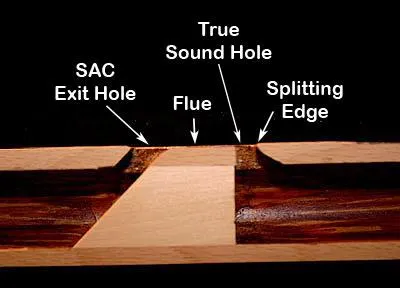
7/8-Inch Bore for F#, G, and A Flutes
Stepping into the world of F#, G, and A flutes, the bore size shrinks to 7/8 inches. Side to side, it reaches a maximum width of 1 19/32 inches, while from top to bottom, it measures 1 7/32 inches.
3/4-Inch Bore for B and C Flutes
As we descend into the realm of B and C flutes, the bore size further reduces to 3/4 inches. Its maximum width, when measured side to side, extends to 1 9/16 inches, while from top to bottom, it measures 1 7/16 inches.
Unveiling the Inner Structure
Now that we have a grasp of bore sizes and their respective keys, let’s journey deeper into the flute’s inner sanctum. Picture the flute cut in half lengthwise, revealing its intricate internal structure.
Blow Hole and Slow Air Chamber (SAC)
At the very heart of the flute lies a 3/8 inch diameter blow hole leading to the Slow Air Chamber. The SAC is sealed with epoxy resin, serving as a formidable shield against moisture absorption, a potential threat to the flute’s integrity.
A Protective Plug
Ensuring a snug separation between the SAC and the flute’s bore, a plug made from a birch dowel soaked in polyurethane stands guard. The polyurethane infusion prevents moisture absorption and any undesirable expansion in diameter, a potential trigger for cracks.
Guiding the Air with the Ramp
The Ramp, a subtle yet vital component, gently guides air from the SAC to the flue. It’s essential for ensuring a smooth flow of air in, through, and out of the SAC, ultimately impacting the flute’s tonal quality.
The Flue: Conductor of Sound
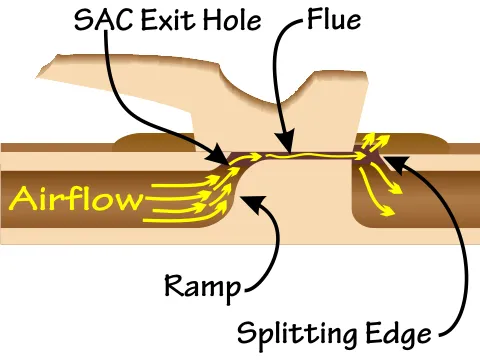
Embedded within the body of the flute, the Flue takes center stage. It acts as the conduit, carrying air from the SAC and directing it against the Splitting Edge. This precise alignment in the center of the air stream’s exit is critical for achieving both volume and clarity of tone.
The True Sound Hole (TSH)
Opposite the SAC exit hole lies the True Sound Hole, the very heart of the flute’s sound-generating mechanism. The dimensions of the TSH are of utmost importance for sound quality, and all its surfaces must be pristine and smooth.
The Sealed Bore
Finally, the bore of the flute is sealed with a protective coat of polyurethane, meticulously sanded to perfection. This sealed, smooth bore is a cornerstone of exceptional tonal quality.
Is Native American flute easy?
If you’ve ever been drawn to the hauntingly beautiful melodies of the Native American flute, you’re in for a treat. Blue Bear Flute’s Beginner 6 Hole Native American Flutes are here to make your musical dreams a reality, whether you’re a first-time player, a seasoned expert, or fall anywhere in between.
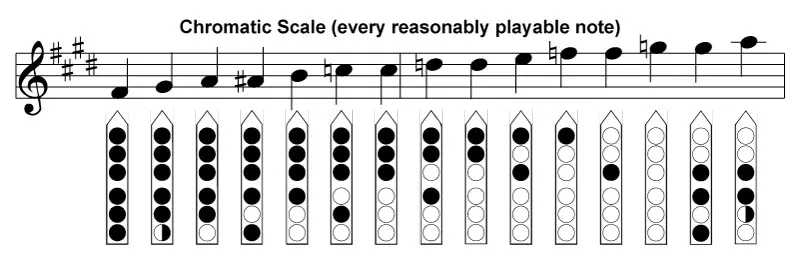
Let’s dive into what makes these flutes the ideal choice for anyone looking to embark on a melodic journey.
A Musical Companion for All
One of the most wonderful aspects of these flutes is their versatility. Whether you’re a novice eager to explore the world of music or a seasoned performer, these flutes have something to offer.
Perfect for Beginners
If you’re taking your first steps into the enchanting realm of the Native American flute, these instruments are your perfect starting point. They’re designed to make learning effortless and enjoyable.
Ideal for Intermediate and Expert Players
Seasoned players will appreciate the craftsmanship and tonal quality of these flutes. They offer a range and depth that can satisfy even the most discerning musicians.
A Classroom Favorite
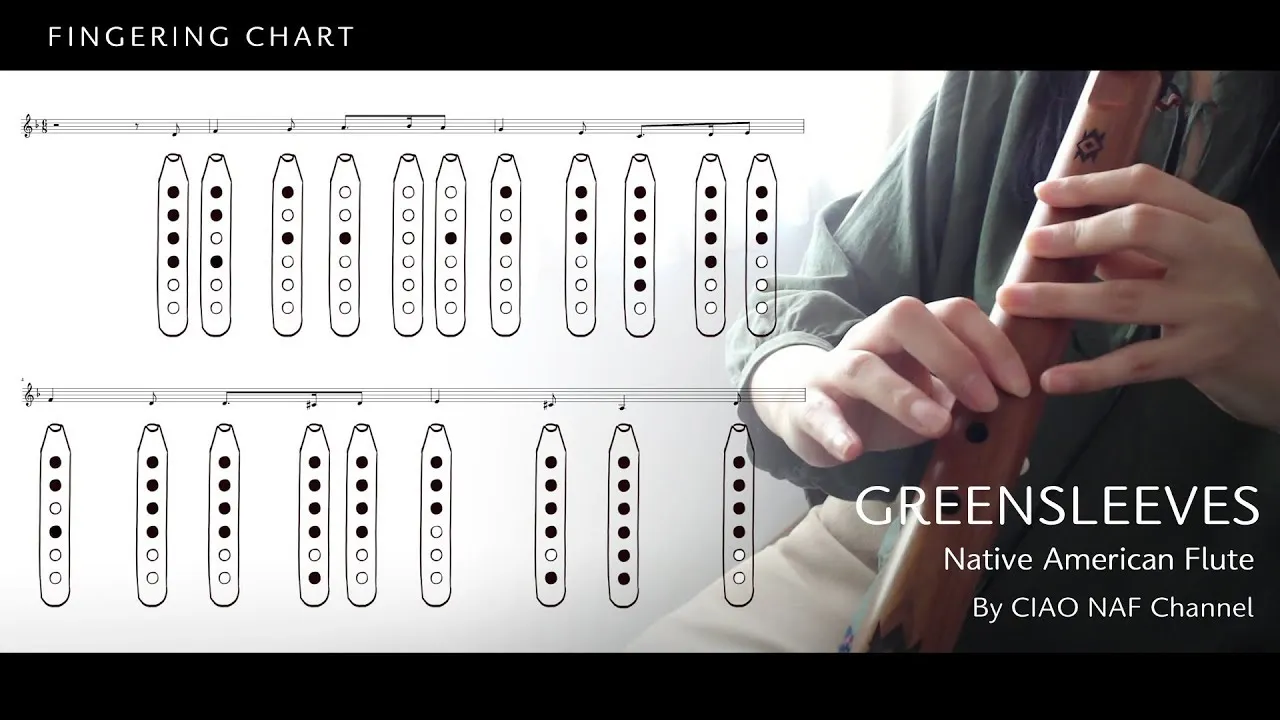
Are you an educator or part of a school music program? These flutes are fantastic additions to any classroom or school. They’re easy to play, making them accessible to students of all ages and skill levels. Affordable Excellence.
Budget-friendly without compromising on quality, these flutes are a fantastic choice for anyone who wants an authentic Native American flute experience without breaking the bank.
Craftsmanship That Speaks Volumes
Blue Bear Flute’s Beginner flutes are a testament to exquisite craftsmanship. They pay homage to the traditional Cane Flutes that have echoed through the Americas for centuries.
Sustainably Grown Hardwood Poplar
These flutes are made from sustainably grown Hardwood Poplar, ensuring that your musical journey has a minimal environmental footprint.
Naturally Safe Stain Finish
Each flute is stained with a naturally safe stain, giving it a distinctive appearance while prioritizing your safety and well-being.
Bee’s Wax and Oil Finish
The finishing touch involves a blend of bee’s wax and oil, giving the flute a smooth, polished feel and preserving its natural beauty.
The Art of Control

One of the standout features of these flutes is their open-type mouthpiece. This design offers both beginners and experienced players a level of control that’s essential for achieving professional-grade performances.
Easy to Play
Playing these flutes is as natural as gently puckering your lips. By resting the mouthpiece on your bottom lip and placing the flute over your top lip, you can effortlessly regulate the airflow. It’s a technique that requires minimal practice to master.
A Tradition Reimagined
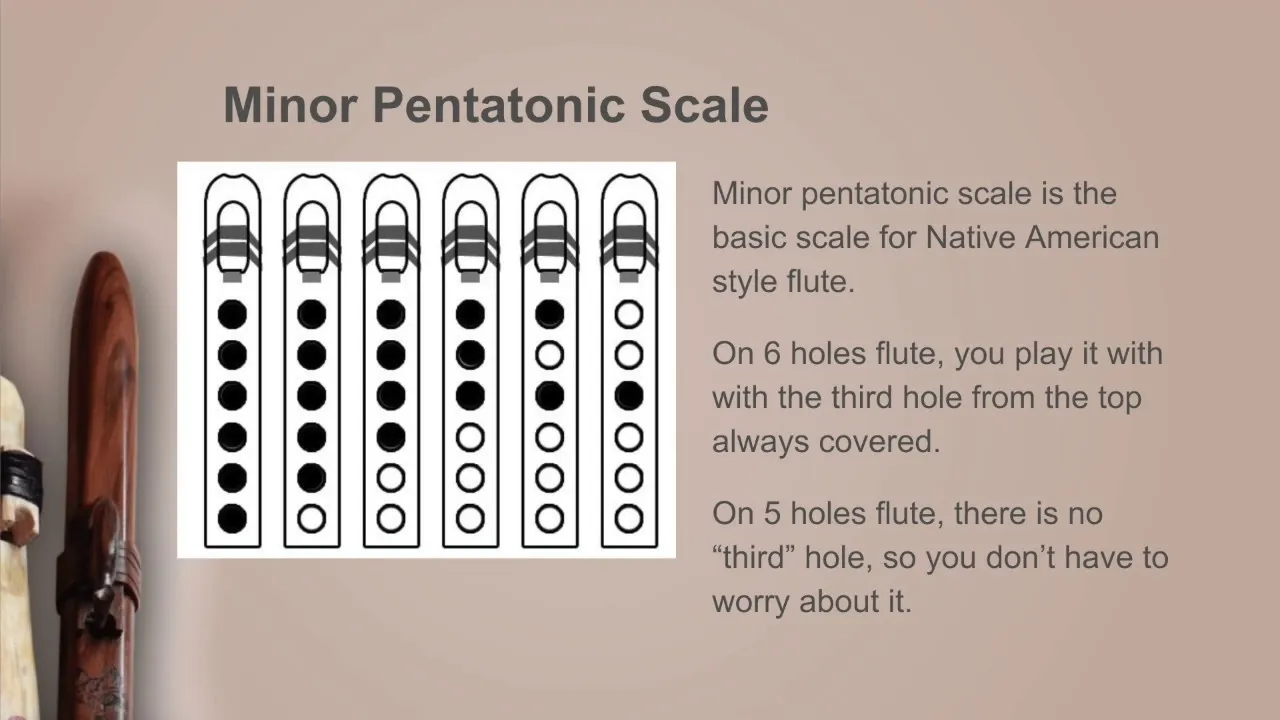
These flutes are “bored through,” a construction method reminiscent of the “Old Style Cane Flutes.” They capture the essence of history while delivering a contemporary musical experience.
The Question of Holes
Many budding musicians wonder about the significance of the number of holes in a flute. Should you choose a 4 hole, 5 hole, or 6 hole flute? Are some more “traditional” than others?
The All-in-One Solution
The truth is, all these variations are deeply rooted in the history of Native American flute making. Blue Bear Flute’s 6 hole Native American Flutes offer the best of all worlds. They’re versatile enough to please seasoned players, yet they’re also perfect for newcomers.
Unleash Your Musical Potential
Don’t be misled by the number of holes. These 6 hole flutes can produce every note that their 4,5 hole counterparts can, and they do it with ease.

